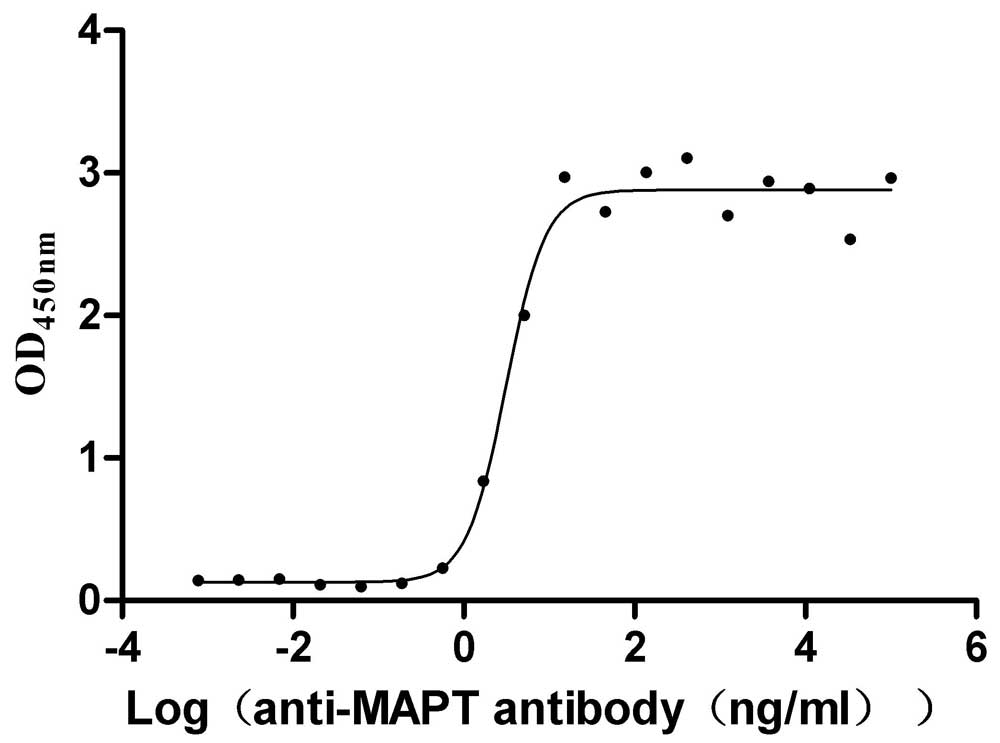Recombinant Loxosceles intermedia Sphingomyelin phosphodiesterase D LiSicTox-alphaII1
-
中文名称:Recombinant Loxosceles intermedia Sphingomyelin phosphodiesterase D LiSicTox-alphaII1,Yeast
-
货号:CSB-YP635219LRA
-
规格:
-
来源:Yeast
-
其他:
-
中文名称:Recombinant Loxosceles intermedia Sphingomyelin phosphodiesterase D LiSicTox-alphaII1,Yeast
-
货号:CSB-EP635219LRA
-
规格:
-
来源:E.coli
-
其他:
-
中文名称:Recombinant Loxosceles intermedia Sphingomyelin phosphodiesterase D LiSicTox-alphaII1,Yeast
-
货号:CSB-EP635219LRA-B
-
规格:
-
来源:E.coli
-
共轭:Avi-tag Biotinylated
E. coli biotin ligase (BirA) is highly specific in covalently attaching biotin to the 15 amino acid AviTag peptide. This recombinant protein was biotinylated in vivo by AviTag-BirA technology, which method is BriA catalyzes amide linkage between the biotin and the specific lysine of the AviTag.
-
其他:
-
中文名称:Recombinant Loxosceles intermedia Sphingomyelin phosphodiesterase D LiSicTox-alphaII1,Yeast
-
货号:CSB-BP635219LRA
-
规格:
-
来源:Baculovirus
-
其他:
-
中文名称:Recombinant Loxosceles intermedia Sphingomyelin phosphodiesterase D LiSicTox-alphaII1,Yeast
-
货号:CSB-MP635219LRA
-
规格:
-
来源:Mammalian cell
-
其他:
产品详情
-
纯度:>85% (SDS-PAGE)
-
基因名:N/A
-
Uniprot No.:
-
别名:Dermonecrotic toxin LiSicTox-alphaII1; EC 4.6.1.-; Dermonecrotic toxin 4; DT4; LiRecDT4; Phospholipase D; Sphingomyelin phosphodiesterase D 4; SMD 4; SMase D 4; Sphingomyelinase D 4
-
种属:Loxosceles intermedia (Spider)
-
蛋白长度:Full Length of Mature Protein
-
表达区域:27-305
-
氨基酸序列ADGR RPIWNMGHMV NGIWQIDQFV DLGVNSIEFD INFDKNGKPV YTYHGVPCDC FRSCLNWEYF GEFLTALRHR TTPGDKLYKE KLILFVFDMK TNSLYDNQAY QAGVNMATDI FKYYWNNGQN GGRAYFILSI PNLNHYDLIK GFRETITKKG HPELMEKVGY DFSANDNIPD VEKAYGKVGV TDHVWQSDGI TNCIARGLSR VKEAVKERDS GGVINKVYIW TIDKFSSTRD ALDAGVDGIM TNYPYVLNDV LKEGAYKNKF RMATYEDNPW VTFKA
-
蛋白标签:Tag type will be determined during the manufacturing process.
The tag type will be determined during production process. If you have specified tag type, please tell us and we will develop the specified tag preferentially. -
产品提供形式:Lyophilized powder
Note: We will preferentially ship the format that we have in stock, however, if you have any special requirement for the format, please remark your requirement when placing the order, we will prepare according to your demand. -
复溶:We recommend that this vial be briefly centrifuged prior to opening to bring the contents to the bottom. Please reconstitute protein in deionized sterile water to a concentration of 0.1-1.0 mg/mL.We recommend to add 5-50% of glycerol (final concentration) and aliquot for long-term storage at -20℃/-80℃. Our default final concentration of glycerol is 50%. Customers could use it as reference.
-
储存条件:Store at -20°C/-80°C upon receipt, aliquoting is necessary for mutiple use. Avoid repeated freeze-thaw cycles.
-
保质期:The shelf life is related to many factors, storage state, buffer ingredients, storage temperature and the stability of the protein itself.
Generally, the shelf life of liquid form is 6 months at -20°C/-80°C. The shelf life of lyophilized form is 12 months at -20°C/-80°C. -
货期:Delivery time may differ from different purchasing way or location, please kindly consult your local distributors for specific delivery time.Note: All of our proteins are default shipped with normal blue ice packs, if you request to ship with dry ice, please communicate with us in advance and extra fees will be charged.
-
注意事项:Repeated freezing and thawing is not recommended. Store working aliquots at 4°C for up to one week.
-
Datasheet :Please contact us to get it.
靶点详情
-
功能:Dermonecrotic toxins cleave the phosphodiester linkage between the phosphate and headgroup of certain phospholipids (sphingolipid and lysolipid substrates), forming an alcohol (often choline) and a cyclic phosphate. This toxin acts on sphingomyelin (SM) wih high activity. It may also act on ceramide phosphoethanolamine (CPE), lysophosphatidylcholine (LPC) and lysophosphatidylethanolamine (LPE), but not on lysophosphatidylserine (LPS), and lysophosphatidylglycerol (LPG). It acts by transphosphatidylation, releasing exclusively cyclic phosphate products as second products. Shows high hemolytic activity. Causes dermonecrosis, induces inflammatory response, platelet aggregation and increases vessel permeability. Shows no lethality when injected at higher dose into mice. May cause complement-dependent hemolysis as well as in a complement-independent manner. The hemolysis provoked in a complement-independent manner may be composed of several steps. The toxin may bind to erythrocyte membranes, may hydrolyze membrane phospholipids (SM and LPC) thus generating metabolism products that may cause hemolysis, probably by provoking an increase of calcium inside cells. The calcium influx may be due to the opening of L-type calcium channels, since L-type calcium channel blockers inhibit calcium influx.
-
亚细胞定位:Secreted.
-
蛋白家族:Arthropod phospholipase D family, Class II subfamily
-
组织特异性:Expressed by the venom gland.
Most popular with customers
-
Recombinant Human B-cell receptor CD22 (CD22), partial (Active)
Express system: Mammalian cell
Species: Homo sapiens (Human)
-
Recombinant Human Prolactin receptor (PRLR), partial (Active)
Express system: Mammalian cell
Species: Homo sapiens (Human)
-
Recombinant Macaca mulatta Microtubule-associated protein tau (MAPT) (Active)
Express system: Mammalian cell
Species: Macaca mulatta (Rhesus macaque)
-
Recombinant Human V-set and immunoglobulin domain-containing protein 4 (VSIG4), partial (Active)
Express system: Mammalian cell
Species: Homo sapiens (Human)
-
Recombinant Macaca fascicularis Membrane spanning 4-domains A1 (MS4A1)-VLPs (Active)
Express system: Mammalian cell
Species: Macaca fascicularis (Crab-eating macaque) (Cynomolgus monkey)
-
Recombinant Macaca fascicularis zymogen granule protein 16 homolog B (ZG16B) (Active)
Express system: Mammalian cell
Species: Macaca fascicularis (Crab-eating macaque) (Cynomolgus monkey)
-
Recombinant Mouse CUB domain-containing protein 1 (Cdcp1), partial (Active)
Express system: Mammalian cell
Species: Mus musculus (Mouse)
-
Recombinant Human C-C chemokine receptor type 9 (CCR9)-VLPs (Active)
Express system: Mammalian cell
Species: Homo sapiens (Human)




















